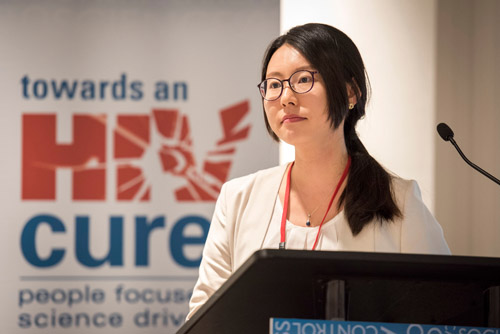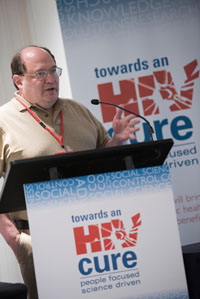One Cure May Not Fit All
By Rowena Johnston, Ph.D.
In these formative stages of HIV cure research, scientists have largely been focused on the challenges presented by the virus and the immune system, leaving considerations of diverse populations of HIV-positive people aside. That is beginning to change. Several presentations at the eighth IAS Conference on HIV Pathogenesis, Treatment and Prevention in Vancouver, July 19–22, addressed differences that may be pertinent to curing HIV in people treated very soon after infection versus later, adults versus children, and men versus women.

Dr. Eunok Lee (Photo: Marcus Rose/IAS)
On the latter front, Dr. Jonathan Karn of Case Western Reserve University presented the first installment in a set of data from a study designed specifically to investigate sex differences that have potential ramifications for curing HIV. The study is supported by funding from the amfAR Research Consortium on HIV Eradication (ARCHE). Dr. Karn and colleagues discovered that the presence of estrogen at levels that are usual in premenopausal women can make it more difficult to flush HIV out of infected cells. The good news is that administering estrogen blockers, such as the breast cancer drug tamoxifen, can facilitate the reactivation of the virus, although this has yet to be tested in a clinical study.
 Dr. Jonathan Karn (Photo: Marcus Rose/IAS)Dr. Eunok Lee, working in the lab of amfAR grantee Dr. Sarah Palmer at the University of Sydney, characterized the cells in which virus persists in people treated within six months of infection versus those treated later. She described very detailed analyses of blood and tissue from these patients that suggest the virus persists in different proportions of various immune cells in each case. Moreover, this pattern of differential distribution points to the possibility that different mechanisms of persistence are being used by infected cells (either by dividing and producing identical copies of themselves, or by responding to infections and generating new copies of themselves). Dr. Lee was awarded the Lange-Van Tongeren Prize for Young Investigators for her outstanding contribution to the conference.
Dr. Jonathan Karn (Photo: Marcus Rose/IAS)Dr. Eunok Lee, working in the lab of amfAR grantee Dr. Sarah Palmer at the University of Sydney, characterized the cells in which virus persists in people treated within six months of infection versus those treated later. She described very detailed analyses of blood and tissue from these patients that suggest the virus persists in different proportions of various immune cells in each case. Moreover, this pattern of differential distribution points to the possibility that different mechanisms of persistence are being used by infected cells (either by dividing and producing identical copies of themselves, or by responding to infections and generating new copies of themselves). Dr. Lee was awarded the Lange-Van Tongeren Prize for Young Investigators for her outstanding contribution to the conference.
 Dr. Katherine LuzuriagaDr. Katherine Luzuriaga of the University of Massachusetts, whose amfAR funding helped characterize the “Mississippi child” a couple of years ago, summarized the current state of knowledge about infection that occurs just prior to or during birth. Almost a quarter of a million babies are born with HIV each year. And while this could be prevented with antiretroviral therapy administered to the mother during pregnancy, about one-third of women do not have access to such programs for the prevention of mother-to-child transmission. There is, though, the opportunity to provide very early treatment to babies born with HIV. Dr. Luzuriaga described emerging data suggesting that in infants the virus persists in different subsets of immune cells than in adults, and that this differential distribution of virus in infants may select for a more favorable outcome and smaller reservoir size if treated before three months of age.
Dr. Katherine LuzuriagaDr. Katherine Luzuriaga of the University of Massachusetts, whose amfAR funding helped characterize the “Mississippi child” a couple of years ago, summarized the current state of knowledge about infection that occurs just prior to or during birth. Almost a quarter of a million babies are born with HIV each year. And while this could be prevented with antiretroviral therapy administered to the mother during pregnancy, about one-third of women do not have access to such programs for the prevention of mother-to-child transmission. There is, though, the opportunity to provide very early treatment to babies born with HIV. Dr. Luzuriaga described emerging data suggesting that in infants the virus persists in different subsets of immune cells than in adults, and that this differential distribution of virus in infants may select for a more favorable outcome and smaller reservoir size if treated before three months of age.
In the first half of 2015, amfAR convened two think tanks to discuss the research opportunities in neonatal HIV infection. Newborns have immature immune systems that have not yet developed the capacity to respond to infections the way adult immune systems do. Learning from these differences may allow us to devise cure interventions specific to infants, and may also shed light on cures for adults.
Dr. Johnston is amfAR’s vice president and director of research.